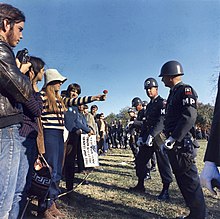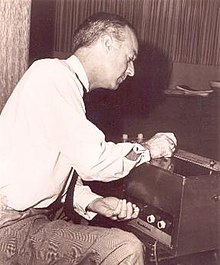Good Vibrations
Building on his approach for Pet Sounds, Wilson recorded a surplus of short, interchangeable musical fragments with his bandmates and a host of session musicians at four different Hollywood studios from February to September 1966, a process reflected in the song's several dramatic shifts in key, texture, instrumentation and mood.[31] AllMusic reviewer John Bush pointed out: "Radio listeners could easily pick up the link between the title and the obviously electronic riffs sounding in the background of the chorus, but Wilson's use of the theremin added another delicious parallel—between the single's theme and its use of an instrument the player never even touched.[33] At that time, theremins were most often associated with the 1945 Alfred Hitchcock film Spellbound, but their most common presence was in the theme music for the television sitcom My Favorite Martian, which ran from 1963 to 1966.[42] According to Love, the lyric "'she goes with me to a blossom world' was originally meant to be followed by the words 'we find'", but Wilson elected to cut off the line to highlight the bass track linking into the chorus.[54] Biographer Peter Ames Carlin wrote that Wilson was so puzzled by the arranging of "Good Vibrations" that he would often arrive at a session, consider a few possibilities, and then leave without recording anything, which exacerbated costs.[nb 5] Brian then forwent additional instrumental tracking until early September, when it was decided to revisit the song's bridge section and apply Electro-Theremin overdubs.[14] Tom Roland of American Songwriter described the piece, "with its interlocking segments—a sort of pop version of the classical sonata, consisting of a series of musical movements".[84] In his book discussing music of the counterculture era, James Perrone stated that the song represented a type of impressionistic psychedelia, in particular for its cello playing repeated bass notes and its theremin.[86] Comparing "Good Vibrations" to Wilson's previous work Pet Sounds, biographer Andrew Hickey said that the "best way of thinking about [the song] is that it's taking the lowest common denominator of 'Here Today' and 'God Only Knows' and turned the result into an R&B track.We have the same minor-key change between verse and chorus we've seen throughout Pet Sounds, the same descending scalar chord sequences, the same mobile bass parts, but here, rather than to express melancholy, these things are used in a way that's as close as Brian Wilson ever got to funky.[88] "Good Vibrations" begins without introduction in a traditional verse/refrain format,[26] opening with Carl Wilson singing the word "I", a triplet eighth note before the downbeat.[51] The sparse first verse contains a repetition of chords played on a Hammond organ filtered through a Leslie speaker; underneath is a two-bar Fender bass melody.[89] Providing a backdrop to the Electro-Theremin is a cello and string bass playing a bowed tremolo triplet, a feature that was an exceedingly rare effect in pop music.Episode 2 however, makes that interpretation untenable, and both listener and analyst must entertain the idea that "Good Vibrations" develops under its own power, as it were, without the guidance of overdetermined formal patterns.[77]The slowed pace is complemented by the lyric ("Gotta keep those loving good vibrations a-happening with her"), sung once first as a solo voice, with the melody repeated an octave higher the second time with an accompanying harmony.This two-part vocal fades as a solo harmonica plays a melody on top of the persistent quarter-note bass line and maraca that maintain the only rhythm throughout Episode 2.[95] Later in the year, Brian told journalist Tom Nolan that the new Beach Boys single was "about a guy who picks up good vibrations from a girl" and that it would be a "monster".[97] Brian also made a rare television appearance on local station KHJ-TV for its Teen Rock and Roll Dance Program, introducing the song to the show's in-studio audience and presenting an exclusive preview of the completed record.[100] Soon after, the Beach Boys were voted the number one band in the world in the NME readers' poll, ahead of the Beatles, the Walker Brothers, the Rolling Stones, and the Four Tops.Club, it also helped turn around the initially poor perception of Pet Sounds in the US, where the album's "un-hip orchestrations and pervasive sadness [had] baffled some longtime fans, who didn't immediately get what Wilson was trying to do."[118] Encouraged by the single's success, Wilson continued working on Smile, intending it as an entire album incorporating the writing and production techniques he had devised for "Good Vibrations"."[132] John Bush wrote that the single "announced the coming era of pop experimentation with a rush of riff changes, echo-chamber effects, and intricate harmonies".[32] Gillett noted: "For the rest of the sixties, countless musicians and groups attempted to represent an equivalently blissful state, but none of them ever applied the intense discipline and concentration that Wilson had devoted to the recording."[127] Priore says that the song was a forerunner to works such as Marvin Gaye's What's Going On (1971) and Isaac Hayes' Shaft (1971) which presented soul music in a similar, multi-textured context imbued with ethereal sonic landscapes.[14] In his appraisal for American Songwriter, Roland cites the song's "format" as the model for recordings by Wings ("Band on the Run"), the Beatles ("A Day in the Life"), and Elton John ("Funeral for a Friend/Love Lies Bleeding").[134] With "Good Vibrations", the Beach Boys ended 1966 as the only band besides the Beatles to have had a high-charting psychedelic rock song, at a time when the genre was still in its formative stages.[31] When the Beach Boys needed to reproduce its sound onstage, Wilson first requested that Tanner play the Electro-Theremin live with the group, but he declined due to commitments."[76] The Beach Boys then requested the services of Walter Sear, who asked Bob Moog to design a ribbon controller, since the group was used to playing the fretboards of a guitar.[146] In early 2011, the single was remastered and reissued as a four-sided 78 rpm vinyl for Record Store Day, as a teaser for the forthcoming The Smile Sessions box set.The details in this section are adapted from The Smile Sessions liner notes, which includes a sessionography compiled by band archivist Craig Slowinski,[159] and the website Bellagio 10452, maintained by music historian Andrew G.










Good Vibrations (disambiguation)Singlethe Beach BoysB-sideLet's Go Away for AwhileStudioWesternColumbiaGold StarProgressive poppsychedelic rockart popacid rockpsychedelic popavant-popsunshine popCapitolSongwriter(s)Brian WilsonMike LoveProducer(s)Wouldn't It Be NiceHeroes and VillainsYouTuberecord chartspop musiccosmic vibrationsextrasensory perceptionFlower PowerSmiley SmilePet Soundssession musiciansHollywoodtextureDerek Taylorpocket symphonystudio as an instrumentpop experimentationpsychedelicprogressive rockjaw harpElectro-ThereminthereminsynthesizersGrammyGrammy Hall of Fame500 Greatest Songs of All TimeRock and Roll Hall of Fame500 Songs that Shaped Rock and Rollthe BeatlesA Day in the LifeBohemian Rhapsodycover versionTodd Rundgrenmusical compositionarrangementChuck BritzPhil SpectorYou've Lost That Lovin' Feelin'Tony Asherviolin bowAllMusicAlfred HitchcockSpellboundsitcomMy Favorite Martiantripletthe CrystalsDa Doo Ron RonVan Dyke ParkschorusSurfin' U.S.A.Help Me, Rhondapsychedelic musicSan FranciscoLos AngelesIf you're going to San Francisco be sure to wear flowers in your hairBruce Goldenpastoralinner spaceinner peacevibrationsEastern philosophyacid-headsextrasensory experienceCapitol RecordsmarijuanaSteven GainesStephen FosterAl JardineDown by the RiversideCBS Columbia Squaretape splicingreverbdecaysthe Wrecking CrewPeter Ames CarlinDomenic PriorePaul TannerGold Star StudiosI Just Wasn't Made for These TimesbridgeDavid AnderleWarner Bros. RecordsWilson PickettDanny Huttonmixdownfuzz bassDennis Wilsonlaryngitis16-tracksectionsMusic theoristDaniel HarrisonrefraindurationAmerican Songwriterclassical sonataNew York Magazinecut-and-paste styleWilliam S. BurroughsSound on Soundavant-garde popmusic of the counterculture eraJohn Robert Greeneexperimental rock